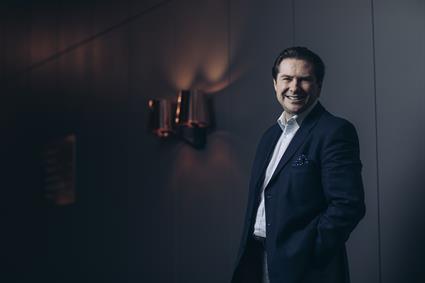

Digital transformation entails more than replacing something analogue for something digital. It means changing the way we work, collaborate, think, and act.
Imagine a spare part being transmitted to the 3D printer on board the ocean going vessel, for ‘instant delivery’ or ships sailing the high seas autonomously, remotely controlled from shore and solar powered. These are some of the visions giving digital industry believers stars in their eyes.
However, according to Marco Ryan, Chief Digital Officer & Executive Vice President at Wärtsilä, new technologies are a driving force, but they constitute just one aspect of digital transformation.
Digitalisation vs digital transformation
“I distinguish between digitalisation and digital transformation,” says Marco Ryan, one of the smartest digital brains in global business and the author of several books on the new digital reality facing businesses. Since September 2016, he has headed the strategic digital positioning at Wärtsilä.
According to Ryan, digitalisation is just making a digital version of something traditionally analogue or developing new technologies. Digital transformation, on the other hand, is something far more comprehensive – which includes all aspects of a business.
At a process level, it involves an extreme-makeover of just about everything: company culture, people, offices, ways of working, in addition to automation, robotics and smart manufacturing.
It also involves new ways of financing, conducting research and developing new projects and services – adopting a more fast-paced Silicon Valley approach, where you develop, build and optimise at speed, based on close collaboration with customers and stakeholders, rather than spending years and millions on secretive research and development, before unveiling your new invention.
At a technology level it involves more than developing new gadgets. It is about building systems interconnecting new technologies. It is about harvesting data and utilising it in new ways, moving away from analysing the past or accessing real-time information to predictive analytics.

President at Wärtsilä.
More than a digital paintjob
“Digital transformation is about fundamentally re-engineering the company. Without it, we cannot create the necessary new business models, find the right people or develop the right technologies,” adds Ryan.
“A common mistake is to talk about digitalisation as taking a can of digital paint and painting over current processes. However, people thinking you can generate new products and services simply by digitalising will fail,” he continues.
A digital paintjob would be to produce a digital version of an old paper manual, and pat yourself on the back because you have ‘gone digital’. Why, the manual is even accessible via a tablet!
However, a digitally-enabled organisation – with the right people, the right culture, and the right mind set – would set a whole new way of thinking in motion. Why not skip the entire manual and introduce a completely new service: direct online access to onshore experts who answer questions in real time? In other words: create new business opportunities for yourself and new and better solutions for the customer, by making a product into a service.
“Integral to the digital transformation thinking is the iceberg analogy. The most important is not the tip of the iceberg, the products and solutions, but what the customer does not see, what lies beneath the surface – our way of working,” says Ryan.
Integral to the company
Many companies create separate digital business units to lead the digital transformation. Marco Ryan believes in a different approach:
“To achieve true digital transformation, digital competencies must become embedded in the entire existing business. Otherwise, instead of new ways of working and thinking, you end up with a group of ‘cool kids’ beside the real business,” he says, adding that he, as Chief Digital Officer at Wärtsilä, he is part of a 17,800 strong team of Wärtsilä employees across the globe.
“I see them all as agents of digital change,” he says.
Instead of a separate digital unit, Wärtsilä has introduced Digital Acceleration Centres across the globe. Here, Wärtsilä plans to join forces with inventors and customers, to speed up innovation and digitalisation. The first centre is already operational in Helsinki, the second is due to open in Singapore later this year while two more are scheduled for 2018.
The Digital Acceleration Centres are also an example of another important factor to achieve a digitally-enabled organisation, what Ryan calls ‘ecosystem thinking, with new ways to partner, built on openness, transparency and trust’. The industry must venture out of its gated community and invite others in, as no industry exists in isolation.
Wärtsilä taking the digital lead
“To digitally enable an analogue manufacturing company, you must do some real work. You need to capture people’s imaginations and emotions, and to empower and free off the organisation to safely create better outcomes faster,” says Ryan, describing his own workplace, Wärtsilä, as a company with the right elasticity and dynamics to achieve the necessary digital transformation, and help its customers do the same.
“We have a culture of innovation,” Ryan says, adding that Wärtsilä is a company that “reinvents itself every generation,” describing how two generations ago, Wärtsilä were ship builders, then became engine manufactures, before becoming the smart technology company it is today – focused on digital stewardship.
As for the shipping industry, as a whole, – how ready is it to fully embrace digital transformation as defined by Marco Ryan?
“I think the industry is more ready than it gives itself credit for. However, digital projects have so far been too ad-hoc to become real engines of growth. The industry needs a stronger support and scalability culture. Otherwise it just becomes a series of digital projects and initiatives not really driving change. And that will just be digital paint on top of the cracks if you are not careful.
Did you like this? Subscribe to Insights updates!
Once every six weeks, you will get the top picks – the latest and the greatest pieces – from this Insights channel by email.


